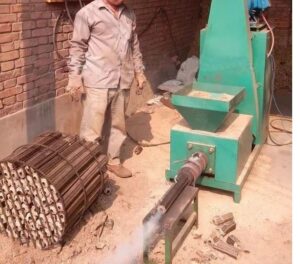Scope of Biomass Briquetting for Cooking
- In the pursuit of sustainable energy sources, biomass briquettes have emerged as an innovative and eco-friendly solution.
- These compact, energy-dense blocks are changing the way we think about renewable energy and waste management.
- As the world grapples with environmental challenges and seeks cleaner, renewable energy sources, biomass briquettes stand as a shining beacon of eco-friendly ingenuity and progress toward a greener future.
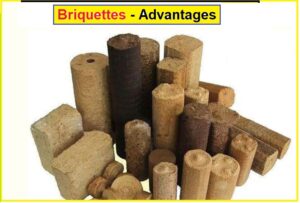
- In the quest for sustainable and renewable energy sources, biomass briquette machines have taken center stage.
- These ingenious devices play a pivotal role in transforming organic waste materials into compact, energy-rich briquettes.
- In this post, we will explore the world of biomass briquette machines, delve into the various types available, and shed light on the cost-efficiency of this eco-friendly technology.
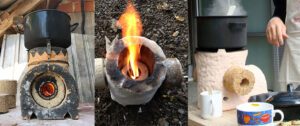
Parts of Biomass Briquetting Machines
- At the heart of biomass briquette is the biomass briquette machine.
- This machine serves as the workhorse that takes raw biomass materials and compresses them into dense briquettes.
- These briquettes can be used as fuel for various applications, offering a cleaner, more sustainable alternative to traditional fossil fuels.
- Biomass briquette machines are intricate pieces of equipment designed to convert raw biomass materials into compact, energy-dense briquettes.
- These machines consist of several essential parts, each with a specific function.
- Here are the main parts of a typical biomass briquette machine
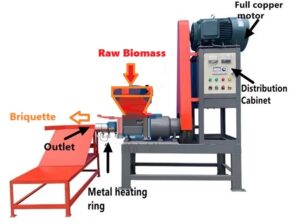
Hopper
- The hopper is the entry point where raw biomass materials are loaded into the machine.
- It holds and feeds the biomass into the machine’s processing chamber.
Screw Conveyor or Auger:
- In screw press briquette machines, a screw conveyor or auger transports the raw biomass from the hopper to the compression chamber.
- It helps in evenly distributing the material and ensures a continuous flow.
Compression Chamber:
- This is the heart of the briquetting machine, where the actual briquetting process takes place.
- The chamber contains the necessary mechanisms to compress the biomass materials under high pressure.
Die or Mold:
- The die or mold is a critical component within the compression chamber.
- It defines the shape and size of the briquette.
- Different dies can be used to produce briquettes of various shapes and sizes.
Rams or Pistons:
- In piston press and hydraulic briquette machines, rams or pistons apply pressure to the biomass material within the compression chamber.
- They are responsible for compressing the material into briquettes.
Briquette Ejection System:
- After the briquettes are formed, there needs to be a mechanism to eject them from the compression chamber.
- This can be a simple hydraulic cylinder or a mechanical system, depending on the machine type.
Pressure Gauge
- Many briquetting machines are equipped with pressure gauges or sensors to monitor and control the pressure applied during the briquetting process.
- This helps ensure consistent briquette quality.
Drive System
- The drive system provides the power needed to operate the machine.
- It can be electric, hydraulic, or mechanical, depending on the machine type and size.
Control Panel:
- Modern briquetting machines often have a control panel that allows operators to set and adjust various parameters, such as pressure, temperature, and production speed.
Cooling System:
- Some machines include a cooling system to cool down the newly formed briquettes as they exit the compression chamber.
- This helps solidify the briquettes and prevent them from sticking together.
Safety Features:
- Safety features like emergency stop buttons and protective guards are essential components to ensure the safe operation of the machine.
Frame and Structure:
- The frame and structure of the machine provide stability and support for all the other components.
- They are typically made from sturdy materials to withstand the high pressures involved in briquetting.
Raw Materials For Biomass briquette Production
- Biomass briquette machines are used to compress organic materials into dense, energy-efficient briquettes that can be used as a renewable source of fuel. The choice of raw materials for biomass briquette production can vary depending on availability and desired characteristics of the briquettes.
- When choosing a raw material for biomass briquette production, it’s essential to consider factors such as moisture content, size, and quality.
- The raw material should ideally have a moisture content of around 10-12% for efficient briquette production.
- Additionally, it’s important to ensure that the raw material is free from contaminants, such as plastics and metals, which can negatively impact the quality of the briquettes and the performance of the briquette machine.
- Here are some common raw materials used in biomass briquette machines:
Wood Chips and Sawdust:
-
- sawdust and wood chips are among the most common raw materials for biomass briquettes.
- They are readily available from woodworking operations and can be compacted into briquettes easily.
Crop Residues:
-
- Agricultural residues like rice husks, wheat straw, corn stalks, and peanut shells can be used as raw materials.
- These are often abundant in farming regions.
Forest Residues:
-
- Various parts of trees, such as bark, branches, and leaves, can be used as biomass feedstock.
- Forest residues can be a valuable resource for briquette production.
Grass and Miscanthus:
-
- Fast-growing grasses like switchgrass and miscanthus are suitable raw materials for biomass briquettes.
- They have a high cellulose content, making them good fuel sources.
Nut Shells:
-
- Shells from nuts like coconut shells, almond shells, and walnut shells can be used to make briquettes.
- They have a high energy content and can be collected from food processing industries.
Bagasse:
-
- Bagasse is the fibrous residue left after sugarcane processing.
- It is a common raw material for briquette production in sugarcane-producing regions.
Paper and Cardboard:
- Waste paper and cardboard can be recycled into briquettes.
- However, they should be free of any plastic or non-biodegradable materials.
Straw of crops
- Straw from cereal crops like wheat, barley, and oats can be used as a raw material.
- It’s important to ensure that straw is dry and free of contaminants.
Husks of Crops
- Husks from various sources can be excellent raw materials for biomass briquettes due to their high cellulose content and availability.
- Here are some common types of husks used for biomass briquette production:
- Rice Husks:
-
- Rice husks are one of the most widely used raw materials for biomass briquettes.
- They are abundant in regions where rice is grown.
- Rice husk briquettes have a high energy content and burn efficiently.
- Coconut Husks:
- Coconut husks, also known as coir, are another valuable resource for biomass briquettes.
- They have a high lignin content, which helps in binding the briquettes together.
- Coconut husk briquettes are used as a fuel source and for various industrial applications.
- Peanut Husks:
- .Peanut husks, a byproduct of peanut processing, can be used for briquette production.
- They are readily available in peanut-producing areas and have good energy content.
- Sugarcane Bagasse:
- While not technically a husk, sugarcane bagasse is a fibrous residue left after sugarcane processing.
- It can be considered a similar biomass feedstock and is commonly used for briquette production in sugar-producing regions.
- Almond Husks:
- Almond husks, a byproduct of almond processing, can be used for making briquettes.
- They have a relatively high energy content and can be collected from almond processing facilities.
- Sunflower Husks:
- Sunflower husks are the outer shell of sunflower seeds.
- They can be used as a raw material for briquette production.
- Sunflower husk briquettes are used as a fuel source.
- Corn Cob Husks:
- Corn cobs, or the husks surrounding the corn kernels, can be used as a raw material.
- They are often available in agricultural areas and can be used to make briquettes.
- Coffee Husks:
- Coffee husks, as mentioned earlier, are a byproduct of coffee production.
- They can be used as a raw material for briquette production and have good calorific value.
- When using husks as raw materials for biomass briquettes, it’s important to properly process and prepare them.
- Typically, the husks need to be dried to reduce their moisture content to around 10-12% for efficient briquette production.
- Additionally, the size and consistency of the husks should be suitable for the briquette machine being used.
- Removing any contaminants and ensuring the husks are free from foreign materials is also important for producing high-quality briquettes.
Miscellaneous Biomass:
- Other biomass sources like banana peels, sugarcane bagasse, and various plant trimmings can be used if they are suitable for briquette production.
Types of Biomass Briquetting Machines
- There are different types of biomass briquette machines, each designed for specific applications and production capacities.
- Here are the most common types:
Screw Press Briquette Machines:
-
- These machines use a screw mechanism to compress the biomass material.
- They are highly versatile and can process various biomass feedstocks. Screw press machines are suitable for small to medium-scale production.
Piston Press Briquette Machines:
-
- Piston press machines operate using a piston and a chamber.
- They offer high compression ratios, making them suitable for producing high-density briquettes.
- These machines are often used for large-scale production.
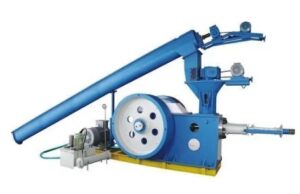
Hydraulic Briquette Machines:
-
- Hydraulic briquette machines use hydraulic cylinders to apply pressure to the biomass material.
- They are known for their high efficiency and can produce briquettes with consistent density.
- Hydraulic machines are often used in large-scale industrial settings.

- Mechanical Stamping Briquette Machines:
- These machines employ a mechanical stamping process to compact the biomass.
- They are robust and capable of producing briquettes with high density.
- Mechanical stamping machines are suitable for medium to large-scale production.
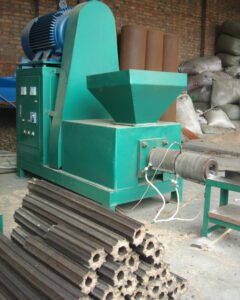
Cost-Efficiency of Biomass Briquetting Machines
The cost of biomass briquette machines can vary widely depending on several factors:
- Machine Type:
- As mentioned earlier, the type of briquette machine significantly affects the cost.
- Simple screw press machines are generally more affordable than hydraulic or mechanical stamping machines.
- Production Capacity:
- Machines designed for higher production capacities tend to be more expensive.
- Small-scale machines intended for home or small business use are typically more cost-effective.
- Automation Level:
- Automation can increase machine costs.
- Fully automated systems that require less manual labor tend to be more expensive than semi-automated or manual machines.
- Material Compatibility:
- Some machines are specifically designed to handle certain types of biomass feedstocks.
- If your material is highly specialized, you may need a machine customized for that purpose, which could be more expensive.
- Brand and Quality:
- The reputation of the manufacturer, the quality of materials used, and the durability of the machine can all influence its cost.
- Maintenance and Operating Costs:
- Consider the ongoing maintenance and operating costs when assessing the overall cost-efficiency of a machine.
Cost Biomass Briquetting Machines in India
- The cost of biomass briquette machines in India can vary widely based on factors such as the type of machine, production capacity, automation level, brand, and features.
- Please note that prices may have changed since then, so it’s important to research current prices from reputable suppliers.
- Here are some approximate cost ranges for different types of biomass briquette machines in the Indian market:
- Small Screw Press Briquette Machines:
- Cost Range: ₹30,000 – ₹1,00,000
- Piston Press Briquette Machines:
- Cost Range: ₹80,000 – ₹2,00,000
- Hydraulic Briquette Machines:
- Cost Range: ₹2,50,000 – ₹15,00,000+
- Mechanical Stamping Briquette Machines:
- Cost Range: ₹1,00,000 – ₹7,00,000
What is the cost of biomass briquette production?
- The overall cost of producing one ton of briquettes is estimated at around Rs 3500 per tonne.
- The gross return of briquettes was Rs 5000 per tonne.
- The net returns of the briquette industry were Rs 1200 per tonne
Government Subsidy on Biomass Briquette Plant
- Indian government provide low-interest loan under the scheme of the Agriculture Infrastructure Fund
- Interest Subvention of 3% per annum if loans up to a limit of Rs. 2 crores up to 7 years
- Credit Guarantee
- No need for any collateral security up to Rs. 2 Crores of loan amount.
- You can state-wide incentives under MSME acts for such biomass production
- Central Government scheme of Ministry of New and Renewable Energy (MNRE),
- Subsidy of Rs. 9 Lakh per MTPH (metric ton/hour) of briquette production
- Maximum benefits of Rs 45 Lakh per plant.
Conclusion
- Biomass briquette machines come in various types and price ranges, making them accessible to a wide range of users, from small businesses to large industrial operations.
- The cost-efficiency of these machines is evident not only in economic terms but also in the positive environmental impact they bring.
- As we continue to seek sustainable energy solutions, biomass briquette machines stand as a beacon of hope for a cleaner and more eco-friendly future.
Reference
- Low cost portable Biomass Briquette machine at low production rate, Thesis

